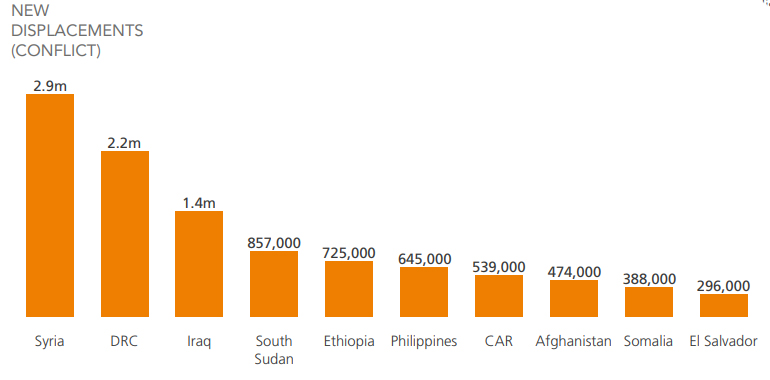The worldwide internal displacement crisis is only getting worse. Over 30 million, that is the number of people who were forced to leave their homes around the world as a result of conflict and disasters last year. That’s roughly 80’000 people displaced every single day! This also represents almost a 50% increase compared to 2016.

These are the astonishing figures released by the Internal Displacement Monitoring Center (IDMC) in their latest report. IDMC is the global leader in the provision of data and analysis on internal displacement and has been publishing global statistics on internal displacement for more than 10 years.
An estimated 40 million people currently displaced due to conflict
As is the case every year, many of the people displaced by conflict in 2017 have been unable to go back to their homes and have been forced to remain in displacement at the end of the year. Together with those living in protracted displacement, that is those who were already living in displacement due to conflict prior to 2017, they make up a population of 40 million.

Some countries are naturally far more affected than others. Seventy-six per cent of the world’s conflict IDPs are concentrated in just ten countries, including Syria, the Democratic Republic of Congo (DRC) and Iraq. In Syria, some 2.9 million people were displaced last year, many for the second or third time, bringing the total number of displaced to 6.8 million in this war-torn country.

In addition to those displaced by conflict and violence, IDMC also reported that 18.8 million people in 135 countries were displaced by natural disasters (floods, storms and cyclones) in 2017.
Of course, these are only estimates and IDMC, which has no presence in the affected countries relies on figures collected by others. Getting accurate figures is complicated by the dynamic nature of displacement but also by a number of problems, including limited geographic coverage across and within countries and challenges in distinguishing between new, secondary or tertiary displacements. Nevertheless, the figures do give us a pretty goood picture of the scale of the problem.
Addressing the root causes of internal displacement
So what does IDMC think should be done to address this problem?
The organisation which has been monitoring internal displacement since 1999 has 3 main recommendations that mainly target countries affected by displacement:
- More involvement at the policy level
- Better account for IDPs and displacement risks
- Mainstream programmes addressing internal displacement into development planning at the local and national level
Necessary? Sure. Enough? Certainly not.
Countries like Syria, DRC and Iraq have indeed the main responsibilities for assisting and protecting their citizen and they are often behind the displacements themselves. However, the responsibility for the violence and instability that plague these countries and drive displacement is surely to be shared at the regional and even global level. Economic interests or geopolitical ones often explain the violent disruptions in these countries in the first place, but they also help to understand also why not more is done to address their root causes.

Only when violences ceases and help is provided can IDPs return to their homes. But for displacement to truly end, we must ensure that governments come together to address the conditions that have led to conflict and violence in the first place, starting with widespread inequalities and the widening gap between the rich and the poor. That is a conversation no government really seems interested in having.



